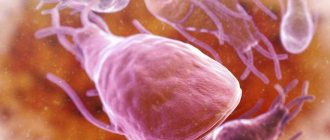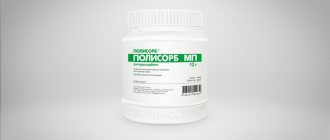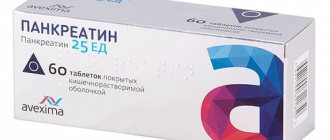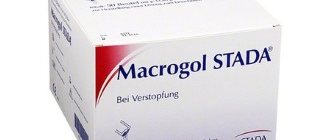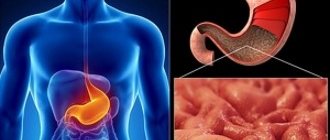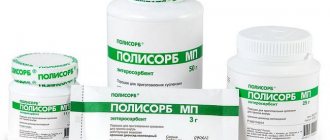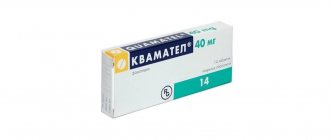The development of pathogenic microorganisms in the intestines often leads to diarrhea, digestive disorders, and inflammatory processes. For treatment in these cases, the antibiotic “Alpha Normix” is used. This is a universal-purpose product, the components of which destroy pathogenic bacteria. The effect is noticeable after the first use.
Pharmacological properties of the drug Alpha Normix
Pharmacodynamics. Rifaximin is a broad-spectrum antibiotic and is a semi-synthetic derivative of rifamycin SV. Irreversibly binds the β-subunits of the bacterial enzyme, DNA-dependent RNA polymerase and, therefore, inhibits the synthesis of RNA and bacterial proteins. As a result of irreversible binding to the enzyme, rifaximin exhibits bactericidal properties against sensitive bacteria. The drug has a wide spectrum of antibacterial activity, including most gram-negative and gram-positive, aerobic and anaerobic bacteria that cause gastrointestinal infections, including traveler's diarrhea. Gram-negative Aerobes: Salmonella spp., Shigella spp., Escherichia coli, including enteropathogenic strains, Proteus spp., Campylobacter spp., Pseudomonas spp., Yersinia spp., Enterobacter spp., Klebsiella spp., Helicobacter pylori ; anaerobes: Bacteroides spp., including Bacteroides fragilis, Fusobacterium nucleatum ; Gram-positive aerobes: Streptococcus spp., Enterococcus spp. , including Enterococcus fecalis, Staphylococcus spp. ; anaerobes: Clostridium spp. , including Clostridium difficile and Clostridium perfrigens, Peptostreptococcus spp. . Absorption of rifaximin in the α polymorphic form in the gastrointestinal tract when taken orally is insignificant (≤1%). The antibiotic acts locally in the intestine, where its high concentration is achieved, significantly higher than the minimum inhibitory concentration for the tested enteropathogenic microbes (after 3 days of therapy, a fecal level of 4000–8000 mcg/g is achieved when taking a daily dose of 800 mg). Due to this, rifaximin has a pronounced antibacterial effect. The use of the drug helps to reduce pathogenic intestinal bacterial flora, which causes some pathological conditions or is involved in their pathogenesis. The drug reduces:
- the formation by bacteria of ammonia and other toxic compounds, which in the case of severe liver disease, accompanied by a violation of the detoxification process, are involved in the pathogenesis of hepatic encephalopathy;
- increased proliferation of bacteria in intestinal microbial overgrowth syndrome;
- the presence of bacteria in the intestinal diverticulum, which may be involved in inflammation in and around the diverticulum and may play a key role in the development of symptoms and complications of diverticulosis;
- antigenic stimuli that, in the presence of genetically determined defects in mucosal immunoregulation and/or protective function, can induce or permanently maintain chronic intestinal inflammation;
- risk of infectious complications during colorectal surgery.
Due to the virtually absent absorption of rifaximin in the gastrointestinal tract, there is no risk of systemic side effects. In numerous clinical studies, rifaximin was always well tolerated by patients. Pharmacokinetics Rifaximin oral absorption is ≤1% based on pharmacokinetic studies in rats, dogs and humans. The drug is not detected in blood plasma after administration in therapeutic doses (detection limit ≤0.5–2 ng/ml) or is detected in very low concentrations (less than 10 ng/ml in almost all cases) both in healthy volunteers and in patients with damaged intestinal mucosa (as a result of ulcerative colitis or Crohn's disease). Rifaximin found in urine is no more than 0.5% of the dose taken orally. Almost all rifaximin taken orally is found in the gastrointestinal tract, where very high concentrations of the drug are achieved (concentrations in feces of 4000-8000 mcg/g are achieved after 3 days of taking the drug at a daily dose of 800 mg). Comparative pharmacokinetic studies have demonstrated that polymorphic forms of rifaximin are absorbed from the intestine in greater quantities than polymorphic form α.
Pharmacodynamics and pharmacokinetics
"Alpha Normix" belongs to the refampicin group of antibiotics. The active component binds parts of bacterial enzymes, inhibits RNA synthesis, which inevitably leads to mass death of pathogenic microorganisms of different groups. The drug allows you to successfully fight gram-positive and gram-negative bacteria.
The active substance of the antibiotic is not absorbed into the intestines and does not enter the blood. The components act only on the pathogenic intestinal microflora, which minimizes the likelihood of side effects. As a result of taking the drug, it is possible to reduce:
- the level of ammonia and other compounds that are products of the vital activity of microorganisms;
- the concentration of bacteria that are present and multiply in colonic diverticula;
- intensity of inflammatory processes with all accompanying symptoms;
- proliferation of pathogenic bacteria, if it is associated with the syndrome of rapid proliferation of intestinal microflora;
- an antigenic stimulus that can cause chronic inflammatory processes in the intestines;
- risk of infection complications during or after colorectal surgery.
The antibiotic acts primarily on the intestinal microflora. No more than 1% is absorbed through the intestinal mucosa. The active substance of the drug is present in the blood in small quantities after administration. The maximum concentration is reached 3 hours after administration. Reaction products are excreted in feces by 99% and in small quantities (up to 1%) in urine.
Use of the drug Alpha Normix
Suspension Adults and children over 12 years of age: 10 ml oral suspension 3 times daily to 20 ml oral suspension 2–3 times daily (600–1200 mg rifaximin). Children aged 6 to 12 years: 10 ml oral suspension 2–3 times daily to 20 ml oral suspension 2 times daily (400–800 mg rifaximin). Children aged 2 to 6 years: 5 ml oral suspension 2-3 times daily to 10 ml oral suspension 3 times daily (200-600 mg rifaximin). For the treatment of adults and children over 6 years of age, instead of an oral suspension, Alpha Normix can be used in the form of film-coated tablets, 200 mg each. Tablets Adults and children over 12 years of age: from 1 tablet 3 times a day to 2 tablets 2-3 times a day (600-1200 mg rifaximin). Children aged 6 to 12 years: from 1 tablet 2-3 times a day to 2 tablets 2 times a day (400-800 mg of rifaximin). The duration of treatment should not exceed 7 days and depends on the clinical effect in patients. If necessary, repeated courses of treatment can be carried out with a break of 20–40 days. The total duration of therapy depends on the adequacy of the clinical effect in patients. Doses and frequency of administration can be changed on the recommendation of a doctor. Preparation of the suspension The granules for the preparation of the oral suspension are in a hermetically sealed bottle. The bottle must be opened, water added to the mark and shaken well. Add water again until the slurry reaches the specified level. The concentration of rifaximin in the finished suspension is 100 mg per 5 ml. To measure 5, 10 or 15 ml of suspension, add a measuring cup. The suspension remains stable for 7 days at room temperature. Before taking the drug, the bottle must be shaken well.
Small intestinal bacterial overgrowth syndrome in chronic pancreatitis
Chronic pancreatitis (CP) is considered as a disease with a complex of severe symptoms, dominated by pain and excretory pancreatic insufficiency (EPI). The causes of the development of these syndromes are chronic obstruction of the pancreatic ducts of varying severity, which impedes the flow of pancreatic juice into the duodenum. Inevitably, EPI is accompanied by impaired digestion and absorption of nutrients, which can lead to the development of malabsorption. It is believed that adequate therapy with enzyme preparations should compensate for the deficiency of endogenous enzymes and restore normal digestion. However, in practice it is not always possible to easily cope with EPI. The main reason for this is usually associated with an insufficient dose of enzyme agents or the choice of an ineffective drug. There is a second, very serious reason for the persistent course of EPI and the seemingly low effectiveness of enzyme therapy. This is associated with the development of small intestinal bacterial overgrowth syndrome (SIBO), known in the English literature as “bacterial overgrowth”. SIBO is little known to a wide range of doctors and is not taken into account in treatment tactics. Therefore, the purpose of this article was to familiarize therapists and gastroenterologists with modern approaches to the correction of SIBO in CP. Normal microflora of the gastrointestinal tract From a modern point of view, the normal human microflora (normoflora, microbiota) is considered as a set of many microbiocenoses that occupy numerous ecological niches (biotopes) on the skin and mucous membranes of all body cavities open to the external environment [1,2]. The total number of bacteria in an adult is 1015 cells, which is more than 10 times the number of the organism’s own cells. The currently existing regulatory document “Russian Industry Standard for Dysbacteriosis” offers the following definition of normal flora: this is “the qualitative and quantitative ratio of diverse populations of microbes of individual organs and systems that maintain the biochemical, metabolic and immunological balance of the macroorganism necessary to maintain human health” [3, 4]. From this definition it follows that the normal flora of each biotope performs numerous functions not only to maintain its functioning, but also the homeostasis of the organism as a whole. The species and quantitative composition of the microflora of each biotope of the gastrointestinal tract (GIT) is quite constant due to the influence of numerous protective factors both from the host organism and the microbiota itself [2]: • Genetic predisposition • Acidic gastric environment • Normal motor-evacuation function of the GIT • Anatomical sphincters of the gastrointestinal tract • Constant level of intraluminal pH in different biotopes • State of the immune system of the mucous membranes • Bactericidal substances produced by the mucous membranes (lysozyme, lactoferrin, etc.) • Phagocytic activity of macrophages of the mucous membrane • Secretory IgA • Bacterial colicins and microcins (endogenous peptide antibiotics microbial origin) More than 400 species of bacteria live in the human gastrointestinal tract alone - representatives of 17 different families [4–6]. The human digestive tract is unevenly populated by bacteria; the composition of the microflora of different biotopes is presented in Table 1. As can be seen from the table, the highest density of microbial contamination in the large intestine is about 400 different species. The total microbial cell biomass of the colon is approximately 1.5 kg, which corresponds to 1011–1012 CFU/g contents and is about 1/3 of the dry weight of feces [7,8]. It is the large intestine, due to such a high contamination, that bears the greatest functional load compared to other biotopes. The bacterial content in the upper intestine fluctuates within a narrow range of 103–104 CFU/ml of intestinal contents. The bulk of bacteria in the colon and lower parts of the small intestine are composed of bacteroides, eubacteria, bifidobacteria, peptostreptococci, ruminococci, clostridia and lactobacilli, and in the upper parts of the small intestine - bacteroides, lactobacilli and cocci (Table 1). Despite the relatively small number of microorganisms in the proximal small intestine, their functions for the life of this biotope are very important, in particular, for maintaining the luminal pH and the immune status of the mucous membrane. The normal microflora of the gastrointestinal tract as a whole performs metabolic, protective, antimutagenic and anticarcinogenic functions. Metabolic and anticarcinogenic functions fall mainly on the flora of the colon, and the microflora of all biotopes participates in the implementation of antitoxic, protective and immune functions, in maintaining colonization resistance and microbial antagonism towards pathogens and conditional pathogens. This equally applies to the upper parts of the small intestine. Colonization resistance is understood as a set of mechanisms that ensure the constancy of the species and quantitative composition of microbial populations in a certain biotope, preventing the proliferation of opportunistic and pathogenic flora and its translocation into uncharacteristic biotopes and into the internal environment of the body. A manifestation of such microflora translocation can be SIBO in the small intestine with an increase in microbial contamination of the latter to more than 104 CFU/ml of intestinal contents [2,3]. Bacterial overgrowth syndrome (excessive contamination syndrome - bacterial overgrowth) As mentioned above, the normal bacterial content in the upper intestine fluctuates in a narrow range of 103-104 CFU/ml of intestinal contents, and this value is a kind of constant for the small intestine. The species composition of the microbiota is also quite constant: bacteroides, lactobacilli, cocci. Summarizing the existing definitions, from our point of view we can give the following definition of SIBO syndrome: bacterial overgrowth syndrome is the contamination of the proximal parts of the small intestine with more than 104 m.c. (CFU)/ml of intestinal contents due to opportunistic microflora coming from the upper gastrointestinal tract (or upper respiratory tract) or due to retrograde translocation of opportunistic representatives of the colon microbiota [2,8–10]. It should be emphasized that the concept of SIBO in the international literature refers to excessive growth of flora only in the small intestine, but not in the large intestine. There are several main mechanisms leading to SIBO [8,10]. The first mechanism is due to hypo- or achlorhydria of any origin. A decrease in the protective acid barrier allows microbes from the oral cavity and upper respiratory tract to colonize the stomach and then the small intestine. This process may be based on various reasons, but most often this path of microbial contamination of the small intestine occurs after gastrectomy or gastrectomy, with long-term use of gastric secretion inhibitors, with autoimmune gastritis, with autoimmune diseases such as pernicious anemia and scleroderma. The second mechanism for the development of SIBO is due to a violation of the so-called “intestinal clearance”, i.e. impairment of the ability of the small intestine to eliminate pathogenic or opportunistic microorganisms that have entered it. Impaired clearance occurs when the activity of protective mechanisms that maintain the constancy of the microbiota of the small intestine decreases: inhibition of motor activity, decreased synthesis of bactericidal substances and secretory IgA, decreased phagocytic function of macrophages of the small intestine mucosa, etc. The third mechanism is associated with retrograde translocation of microflora from the large intestine to the small intestine due to insufficiency of the ileocecal valve due to inflammation or motor disorders of the colon. Almost any gastroenterological disease can lead to the development of SIBO (Table 2). Methods for assessing SIBO Diagnosing SIBO is very difficult because... methods for collecting the contents of the small intestine are too labor-intensive. For this purpose, a simple and convenient method has been developed to determine the concentration of hydrogen in exhaled air after a carbohydrate load with glucose or lactose (breathing hydrogen test) [8]. When you have SIBO, the level of hydrogen in the exhaled air is high due to the formation of microbial metabolites in the small intestine. The same method can be used to monitor the results of treatment with various drugs that suppress the growth of excess flora in the small intestine. The method is cheap and easy to implement, but, unfortunately, is not widespread in Russia. Chronic pancreatitis and SIBO According to JE Dominguez-Munoz, SIBO occurs in 40% of patients with CP and is one of the most common causes leading to insufficient effectiveness of enzyme replacement therapy [11]. Numerous mechanisms leading to impaired digestion and SIBO in CP are presented in detail in Figure 1. Thus, CP is accompanied by: • impaired digestion and absorption processes • development of excessive bacterial growth in the small intestine • impaired motor function of the gastrointestinal tract Initial disturbance of cavity digestion in CP by the interaction of complex mechanisms is aggravated by disruption of membrane digestion, and all participating mechanisms act on the principle of a vicious circle. Treatment of bacterial overgrowth syndrome It should be borne in mind that SIBO is not an independent pathology, but only a secondary syndrome that accompanies many pathological conditions. If, with disorders of the microbiota of the colon, as a rule, there are no clearly defined clinical symptoms, then with SIBO, flatulence, stool disorders, and sometimes severe diarrhea usually occur. At the same time, all of these symptoms are not specific, and it is not possible to unambiguously associate them with SIBO. In the context of this article, flatulence, diarrhea, and stethorrhea can equally be a consequence of both EPI and SIBO. In any case, microbial disorders in both the large and small intestines are always secondary, so to correct them it is necessary first of all to eliminate the negative factors that cause them (for example, medicinal or environmental influences) or to treat the underlying disease. It is important to emphasize that correction of SIBO is not an end in itself and is carried out: • if it is impossible to eliminate its cause • under the influence of a constant aggressive factor (for example, chemotherapy) • as an additional measure, if the treatment of the underlying disease that caused these disorders is insufficient. An ideal illustration of these provisions is SIBO, which develops against the background of EPI. Ideally, when an adequate dose of enzyme preparations is prescribed, digestion is restored and additional correction of SIBO is not required. However, SIBO is one of the most common reasons leading to insufficient effectiveness of enzyme replacement therapy [11]. In one study, the effect of Creon therapy on SIBO (according to the hydrogen breath test) was assessed in 15 patients with EPI in CP. These patients for 2 months. were treated with Creon 100–150 thousand IU per day. In the majority (65% - 10 patients), according to the repeated hydrogen test, SIBO was eliminated, in 53% (8 patients) flatulence disappeared, in 73% (11 patients) there was an improvement in health, but dyspeptic symptoms persisted [12]. Based on the above, the administration of adequate doses of effective enzyme agents (Creon 25,000–40,000 IU with each meal) should be first-line therapy for pancreatic diseases with EPI with or without SIBO. If its effectiveness is insufficient, the prescription of drugs to eliminate microbial growth in the small intestine is indicated. Therapeutic tactics for microbial disorders depend on the degree of their severity, the presence of clinical manifestations, and translocation of bacteria to other biotopes. In some cases, in the presence of SIBO, it becomes necessary to carry out “selective microbial decontamination of the intestines.” This concept implies sanitization of the intestines (decontamination) with drugs that selectively suppress the growth of foreign flora and do not affect the normal flora. For the purpose of decontamination, several groups of agents are used: • antibacterial drugs • non-pathogenic fungi • spore-forming drugs based on representatives of transient flora • microbial metabolites. Antibiotics The optimal antibacterial drug for decontamination of the small intestine and elimination of SIBO must meet the following requirements: • have minimal absorption from the intestine • create a high concentration in the intestinal cavity • have selectivity (must suppress foreign flora and not affect normal flora • have a wide spectrum of antimicrobial action, including aerobes and anaerobes • have a minimum of side effects and be safe • have proven clinical effectiveness One of the new drugs in Russia and the most interesting from all three points of view is a derivative of rifamycin - the drug rifaximin (Alfa-normix). It is not absorbed (<1%) when taken orally, an antibiotic that reaches high concentrations in the gastrointestinal mucosa. The drug does not act outside the gastrointestinal tract, i.e. it is a local intestinal antiseptic. Rifaximin is well tolerated, has a minimum of side effects and does not cause bacterial resistance. The drug has a wide spectrum of antibacterial action against gram-positive (Enterococcus spp, M. tuberculosis, Streptococcus pyogenes, Streptococcus faecalis, Streptococcus pneumoniae, Staphylococcus epidermidis, Staphylococcus aureus) and gram-negative (Escherichia coli, Shigella spp, Salmonella spp, Yersinia enterocolica, Proteus spp, Vibrio cholerae) aerobic bacteria and gram-positive ( Clostridium perfrigens, Clostridium difficile, Peptococcus spp, Peptostreptococcus spp) and gram-negative (Bacteroides spp, Bacteroides fragilis, Helicobacter pylori) anaerobes [13]. This spectrum of action determines the therapeutic capabilities of the drug. Thus, rifaximin meets all the basic requirements for an ideal antibacterial drug. It is successfully used for acute intestinal infections, for the sanitation of the colon in case of “dysbacteriosis”, for the correction of SIBO, for antibiotic-associated intestinal lesions and for hepatic encephalopathy. For SIBO, proven using a hydrogen breath test, rifaximin is used 400 mg 3 times a day for 7 days. At the same time, the level of exhaled hydrogen decreases by 3–5 times already by the third day of treatment, which indicates rapid sanitation of the small intestine [14]. For a long time, various antibiotics (tetracyclines, lincomycin, ampicillin, etc.) have been used to treat SIBO in various pathologies, which are not selective, do not act on anaerobic flora, are quickly absorbed from the gastrointestinal tract and have a wide range of side effects (including antibiotics). -associated diarrhea) and suppress normal flora. To demonstrate the effectiveness of rifaximin, a double-blind study was conducted confirming the priority of rifaximin over tetracycline in SIBO [15]. In this study, SIBO in two groups of patients was assessed using a hydrogen breath test and the peak excretion of hydrogen in exhaled air and the total hydrogen concentration after a glucose load were determined before and 3 days after the end of the antibiotic course. It was shown that at equal initial levels of hydrogen, its peak after a glucose load, as well as the total concentration in exhaled air after treatment, was significantly lower in patients receiving rifaximin compared with the group receiving chlortetracycline. Other effective antibacterial agents include hydroxyquinolone derivatives, low-absorbable nitrofuran derivatives (nifuroxazide) and nitroimidazoles (metronidazole, tinidazole) [2,14]. Although the latter group is absorbed from the colon, its use is nevertheless effective mainly in cases of contamination with anaerobic microorganisms. The duration of the decontamination course for SIBO is 12–14 days. Non-pathogenic fungi In case of intolerance to antibacterial drugs, it is possible and effective to prescribe drugs based on non-pathogenic yeast fungi of the genus S. boulardii. At the same time, S. boulardii does not suppress the growth of obligate microorganisms in the intestinal cavity and is resistant to the action of hydrochloric acid. When taken daily, they are found in all parts of the gastrointestinal tract, including the small intestine. This yeast is a transient flora for humans, therefore, 2–5 days after the end of taking the drug, it is completely eliminated from the body without side effects. The drug is not absorbed from the gastrointestinal lumen and is a local intestinal antiseptic. The antimicrobial effect of S. boulardii was established in vitro and in vivo against pathogens of intestinal infections (Cl. difficile, Salmonella, Shigella, Yersinnia), protozoa (Giardia and a number of) opportunistic microorganisms (pathogenic cocci, fungi, Klebsiella, etc.) , which can lead to the development of SIBO [16]. Spore-forming apathogenic antibacterial agents can also be used for SIBO, as an alternative to antibiotics in case of intolerance. This group includes drugs based on Bacillus subtilis and a similar microorganism, B. cereus. Spore microorganisms are transient flora for humans, therefore they are quickly eliminated from the intestines after the cessation of the intake. The mechanism of action of these drugs is due to the formation of acidic metabolites in the process of vital activity and a decrease in pH throughout the intestines, due to which the growth of conditionally pathogenic flora is inhibited. In addition, these products synthesize a number of digestive enzymes, partially compensating for the decrease in the intestine’s own enzyme activity in case of damage to bacteria and their toxins. The course of treatment for SIBR is 10-14 days. A longer course is undesirable, because B. cereus can produce enterotoxins that provoke diarrhea [6]. Microbial metabolites with an additional remedy that restores the microflora of the mainly small intestine is a microbial metabolite of Hilak Forte [17]. The main biologically active components that are part of Hilak Fort are short -chain fatty acids (KVK) and lactic acid obtained from sugarlytic and proteolytic representatives of normal intestinal microflora. The concentration of biologically active substances in one drop of the drug corresponds to the action of the corresponding metabolites of 1010 bacteria. The mechanism of action of Hilak Forte on the normalization of the composition and functions of the microbiota and to restore the intestines are mediated by the components included in it. The KZHK contained in the drug provides mucous membranes with additional energy, contribute to the regeneration of damaged epithelial cells of the intestinal wall, and improve the trophic of the mucosa. The effect of acidic metabolites (KZHK, lactic acid) ensures the regulation of intra -light pH, which leads to inhibiting the growth of pathogens and conditionally pathogens throughout the intestine. Thus, the tactics of the treatment of CP with Siberiasis should be built as follows: • adequate enzyme therapy (creon 75000 IU and more per day) • DECOMENTMENTION OF THE SUSHE: Antibacterial therapy (rifamacin) • Microbial metabolites • Normalization of microbiocenosis of the colon and prebiotics (when necessity) • elimination of motor disorders - duodenal hypertension, accelerated checkpoint (if necessary).
Literature 1. Ardatskaya M.D., Minushkin O.N., Ikonnikov N.S. “Intestinal dysbiosis”: concept, diagnostic approaches and ways of correction. Possibilities and advantages of biochemical research of feces. – A manual for doctors. – M., 2004. 2. Belousova E.A. Small intestinal bacterial overgrowth syndrome in the light of the general concept of intestinal dysbiosis. A look at the problem. //Farmateka, 2009, No. 2 p. 3. Bondarenko V.M. The role of opportunistic intestinal bacteria in human multiorgan pathology. M.: Triada, 2007. 4. Bondarenko V.M., Gracheva N.M., Matsulevich T.V. Intestinal dysbacteriosis in adults. – M. KMK Scientific Press. – 2003. – 224 p. 5. Shenderov B.A. Medical microbial ecology and functional nutrition. In 3 volumes. M.: Grant, 1998. 6. Korovina N.A., Zakharova I.N., Kostadinova V.n. and others. Prebiotics and probiotics for disorders of intestinal microbiocenosis in children. A manual for doctors. Medpraktika - M., 2004. 7. Doronin A.F., Shenderov B.A. Functional nutrition. – M.: Grant, 2002. – 296 p. 8. Gut Microflora. Digestive Physiology and Pathology. Ed. J–C. Rambaud, J-P. Buts et all. JL Eurontext. Paris. 2006. 9. Parfenov A.I. Enterology. – M.: Triada, 2002. 10. Approach to the patients with chronic gastrointestinal disorders. Ed. E. Corazziari. MESSAGGI. 2000. 11. Dominguez–Munoz JE Pancreatic enzyme therapy for pancreatic exocrine insufficiency. Curr. Gastroenterol Rep. 2007, 9(2): 116–122. 12. Pap A. et al. The effect of Creon therapy on SIBO in patients with pancreatic congenital heart failure. Abstracts from the 35th European Pancreatic Club Meeting. Pancreatology, 2003; 3: 240. 13. Rifaximin: a Poorly Absorbed Antibiotic. Ed. C. scarpingato. Karger.2005. 14. Di Stefano M., Corazza GR Treatment of small bowel bacterial overgrowth and related symptoms by Rifaximin. In: Rifaximin: a Poorly Absorbed Antibiotic. Ed. C. scarpingato. Karger. 2005. 15. Di Stefano M., Malservisi S., Veneto G., Corazza GR Rifaximin versus chlortetracycline in the short term treatment of small intestinal bacterial overgrowth. Aliment Pharmacol Ther 2000; 14:551–556. 16. Belousova E.A. Saccharomyces boulardii (Enterol) in gastroenterological practice (literature review). //Pharmateka, 2006, No. 12. pp. 68–72. 17. Belousova E.A., Nikitina N.V., Mishurovskaya T.S., Zlatkina A.R. Possibilities of drugs based on microbial metabolites for restoring intestinal microbiota // Consilium, 2005, No. 1, p. 9–13.
Side effects of the drug Alpha Normix
Analysis of safety data showed that the risk of side effects when using Alpha Normix is very low. These effects are limited primarily to gastrointestinal disturbances (nausea, dyspepsia, vomiting, abdominal pain and cramps), are mild to moderate and usually self-limit without the need for dose changes or interruption of therapy. The drug is practically not absorbed from the gastrointestinal tract, which eliminates the risk of developing systemic side effects. In rare cases, skin reactions such as urticaria may occur, which are likely due to individual intolerance to treatment. The risk of side effects is 0.7–2% of all cases of drug use. Post-marketing surveillance data confirm the above risk assessment and the nature of the observed events.
Contraindications and side effects
The drug is indicated for patients with various diseases, with the exception of:
- all types of intestinal obstruction;
- ulcerative intestinal lesions;
- individual intolerance to the active or auxiliary components of the tablets;
- the appearance of allergic reactions;
- Also, the drug should not be given to children under 12 years of age (by agreement with the doctor, the suspension can be given to children from 2 years of age).
One of the advantages of Alpha Normix antibiotics is the absence or extremely rare occurrence of side effects. However, in rare cases, the following consequences may occur:
- nausea;
- vomit;
- pain in the epigastric region;
- headaches;
- dizziness;
- loss or disturbance of taste;
- increased blood pressure;
- dyspnea;
- weakness, cold sweat;
- Quincke's edema;
- rash;
- diarrhea;
- heartburn.
In most cases, symptoms disappear without additional medications within the first hours after administration. If they persist for several days, the Alpha Normix tablets and suspension are discontinued. Symptomatic treatment and change of course are indicated. To do this, you must consult a doctor.
Special instructions for the use of Alpha Normix
During prolonged treatment with high doses or when the intestinal mucosa is damaged, a small amount of the drug (≤1%) may be absorbed, which can cause urine to turn reddish. This is due to the active substance, which, like most antibiotics of this series (rifamycins), has a red-orange color. Use during pregnancy and lactation. Rifaximin did not cause teratogenic effects in rats and rabbits. Adequate data and well-controlled studies in pregnant women are lacking. Since reproductive toxicity studies in animals do not allow assessment of the possibility of a toxic effect in humans, during pregnancy the drug should be taken only in cases of urgent need and under the direct supervision of a physician. The penetration of rifaximin into breast milk has not been studied, but is expected to be negligible due to very low absorption into the systemic circulation. Therefore, the use of Alpha Normix by women who are breastfeeding is permitted with appropriate medical supervision. The ability to influence the reaction rate when driving vehicles or other mechanisms. Not installed.





